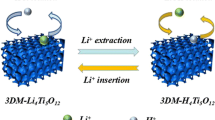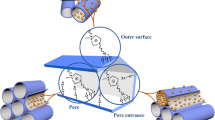Abstract
The long-chain ionic liquid (IL) hexadecyl-4-aza-1-azoniabicyclo[2.2.2]octane bromide was used as a template to prepare the hexagonally ordered siliceous mesoporous molecular sieve MCM-41 as well as the disordered mesoporous molecular sieve designated as KIT-1. The synthesized products were studied via X-ray diffraction (XRD), Fourier transform infrared (FTIR), N2 adsorption-desorption analysis, scanning electron microscopy (SEM) and transmission electron microscopy (TEM). Also, the surface area (BET), pore volume, and pore diameter (BJH) are determined. These kind of ILs which have 1,4-diazabicyclo[2.2.2]octane (DABCO) in their structures, were prepared with an easy method. When the two templates, cetyltrimethylammonium bromide (CTAB) and IL, have the similar structures, MCM-41 mesoporous molecular sieve produced with more ordered, uniform mesoporous channel and high surface area in comparison to without IL. When just IL used instead of CTAB, the KIT-1 with non-uniform mesoporous was obtained. Here we prepared the KIT-1 mesoporous molecular sieve with IL without CTAB. Also, using dual template CTAB and DABCO based IL leads to increase the pore walls of products. It seems, using dual template with changing IL structures in fabricated of molecular sieve provide new opportunity to design targeted adsorbents and catalysis.
Graphical abstract

Similar content being viewed by others
References
Machado SWM, Santana JC, Pedrosa AMG, Souza MJB, Coriolano ACF, Morais EKL (2018) Catalytic cracking of isopropylbenzene over hybrid HZSM-12/M41S (M41S = MCM-41 or MCM-48) micro-mesoporous materials. Pet Sci Technol 36:923–929. https://doi.org/10.1080/10916466.2018.1454950
Ryoo R, Kim JM, Ko CH, Shin CH (1996) Disordered molecular sieve with branched mesoporous channel network. J Phys Chem 100:17718–17721. https://doi.org/10.1021/jp9620835
Gholamzadeh P, Mohammadi Ziarani G, Badiei A (2017) Immobilization of lipases onto the SBA-15 mesoporous silica. Biocatal Biotransfor 35:131–150. https://doi.org/10.1080/10242422.2017.1308495
Alothman ZAA (2012) Review: fundamental aspects of silicate mesoporous materials. Materials. 5:2874–2902. https://doi.org/10.3390/ma5122874
Li Z, Zhang Y, Feng N (2019) Mesoporous silica nanoparticles: synthesis, classification, drug loading, pharmacokinetics, biocompatibility, and application in drug delivery. Expert Opin Drug Deliv 16:219–237. https://doi.org/10.1080/17425247.2019.1575806
Sanaeishoar H, Sabbaghan M, Mohave F (2015) Synthesis and characterization of micro-mesoporous MCM-41 using various ionic liquids as co-templates. Micropor Mesopor Mat 217:219–224. https://doi.org/10.1016/j.micromeso.2015.06.027
Liu L, Xiong G, Wang X, Cheng X (2011) Synthesis of Nanosized AlKIT-1 mesoporous molecular sieve and its catalytic performance for the conversion of 1,2,4-Trimethylbenzene. Catal Lett 141:1136–1140. https://doi.org/10.1007/s10562-011-0580-8
Roto R, Kartini I, Motuzas J, Triyana K, Siswanta D, Dwi Wahyuningsih T, Kusumaatmaja A (2019) Rapid synthesis of MCM-41 from Rice husk using ultrasonic wave: Optimation of sonication time. Mater Sci Forum 948:198–205. https://doi.org/10.4028/www.scientific.net/MSF.948.198
Coutino-Gonzalez E, Manriquez J, Robles I, Espejel-Ayala F (2018) Synthesis of MCM-41 material from acid mud generated in the aluminum extraction of kaolinite mineral. Enviro Prog Sustain Energy doi: 101002/ep13069
Loganathan S, Kumar K, Ghoshal AK (2019) Fabrication of mesoporous silica MCM-41 via sol-gel and hydrothermal methods for amine grafting and CO2 capture application. Urban Ecology, Water Quality and Climate Change 38:341–349. https://doi.org/10.1007/978-3-319-74494-0_26
Azizi SN, Ghasemi S, Rangriz-Rostami O (2018) Synthesis of MCM-41 nanoparticles from stem of common reed ash silica and their application as substrate in electrooxidation of methanol. Bull. Mater. Sci 88:1–13. https://doi.org/10.1007/s12034-018-1580-8
Ryoo R, Kim JM, Shin CH, Lee JY (1997) Synthesis and hydrothermal stability of a disordered mesoporous molecular sieve. Stud Surf Sci Catal 105:45–52. https://doi.org/10.1016/S0167-2991(97)80537-X
Taubert A. (2016) Inorganic nanomaterials synthesis using ionic liquids, Encyclopedia of Inorganic and Bioinorganic Chemistry, 1–14 doi: https://doi.org/10.1002/9781119951438.eibc0355.pub2
Li RX (2004) Green solvents: synthesis and application of ionic liquids. Chemistry Technology Press, Beijing
Isambert N, Duque MMS, Plaquevent JC, Genisson Y, Rodriguez J, Constantieux T (2011) Multicomponent reactions and ionic liquids: a perfect synergy for eco-compatible heterocyclic synthesis. Chem Soc Rev 40:1347–1357. https://doi.org/10.1039/C0CS00013B
Sanaeishoar H, Sabbaghan M, Mohave F, Nazarpour R (2016) Disordered mesoporous KIT-1 synthesized by DABCO-based ionic liquid and its characterization. Micropor. Mesopor. Mat. 228:305–309. https://doi.org/10.1016/j.micromeso.2016.04.003
Barrett EP, Joyne LG, Halenda PP (1951) The determination of pore volume and area distributions in porous substances. I. Computations from nitrogen isotherms. J. Am. Chem. Soc. 73:373–380. https://doi.org/10.1021/ja01145a126
Yue Y, Sun Y, Gao Z (1997) Disordered mesoporous KIT-1 as a support for hydrodesulfurization catalysts. Catal Lett 47:167–171. https://doi.org/10.1023/A:1019084400340
Gregg SJ, Sing KSW (11997) adsorption, Surface Area and Porosity; Academic: London
Chen LJ, Xu WH, Zhang JD, Holmes MA, Morris J (2011) Syntheses of complex mesoporous silicas using mixtures of nonionic block copolymer surfactants: understanding formation of different structures using solubility parameters. Colloid Interface Sci 353:169–180. https://doi.org/10.1016/j.jcis.2010.09.043
Wei J, Yue Q, Sun Z, Deng Y, Zhao D (2012) Synthesis of dual-mesoporous silica using non-ionic diblock copolymer and cationic surfactant as co-templates. Angew Chem Int Ed 51:6149–6153. https://doi.org/10.1002/anie.201202232
Wali LA, Khulood KH, Alwan AM (2019) Rapid and highly efficient detection of ultra-low concentration of penicillin G by gold nanoparticles/porous silicon SERS active substrate. Spectrochim Acta A Mol Biomol Spectrosc 206:31–36. https://doi.org/10.1016/j.saa.2018.07.103
Wang T, Kaper H, Antonietti M, Smarsly B (2007) Templating behavior of a long-chain ionic liquid in the hydrothermal synthesis of mesoporous silica. Langmuir 23:1489–1495. https://doi.org/10.1021/la062470y
Acknowledgements
The authors wish to thank the Ahvaz Branch, Islamic Azad University for providing the essential financial support.
Availability of Data and Materials
Not applicable.
Author information
Authors and Affiliations
Contributions
HS: Conceptualization; Methodology; Investigation; Writing. MS: Conceptualization; Visualization; Writing—review and editing and discussion. MG: Methodology and Editing MG: Synthesis SP: Synthesis; Formal analysis.
Corresponding authors
Ethics declarations
Consent to Participate
Not applicable.
Consent for Publication
Not applicable.
Conflict of Interest
The authors declare that they have no conflicts of interest.
Additional information
Publisher’s Note
Springer Nature remains neutral with regard to jurisdictional claims in published maps and institutional affiliations.
Supplementary Information
Supplementary data associated with this article can be found, in the online supplementary content.
ESM 1
(DOCX 1260 kb)
Rights and permissions
About this article
Cite this article
Sanaeishoar, H., Sabbaghan, M., Ghazvini, M. et al. Manufacturing Porous Materials Using Dabco-Based Ionic Liquid. Silicon 14, 6291–6297 (2022). https://doi.org/10.1007/s12633-021-01403-x
Received:
Accepted:
Published:
Issue Date:
DOI: https://doi.org/10.1007/s12633-021-01403-x




